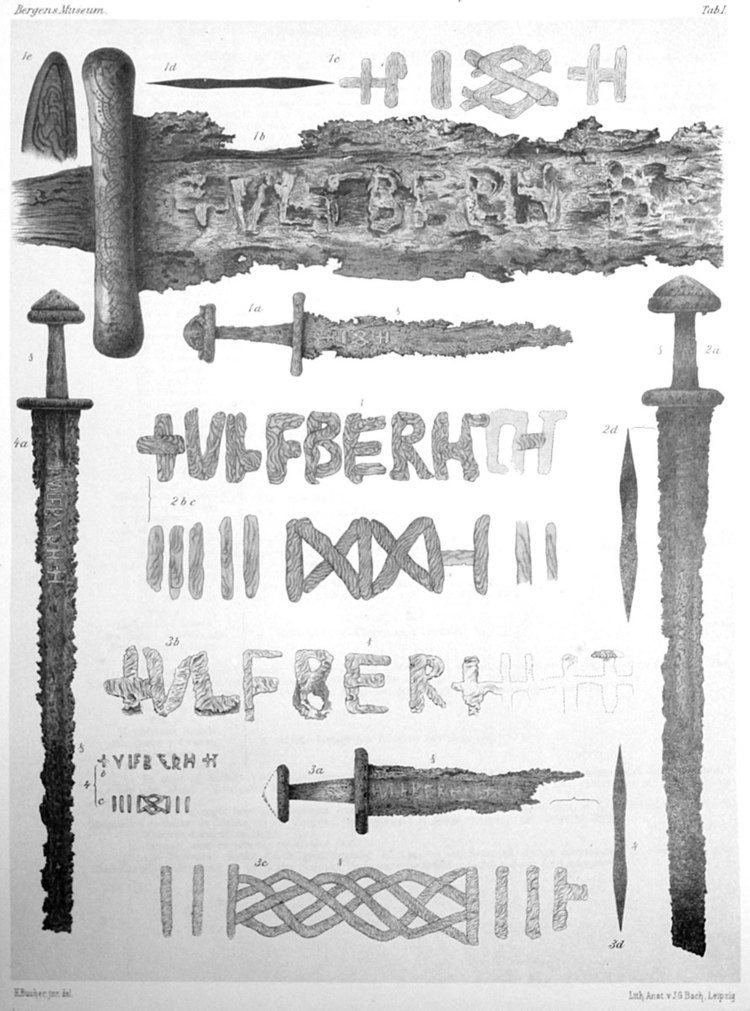Type Sword Weight avg. 1.2 kg (2.7 lb) Width 5 cm (2 in) | Produced 9th to 11th centuries Length avg. 91 cm (36 in) | |
 | ||
Blade type Double-edged, straight bladed, slight taper | ||
The Ulfberht swords are about 170 medieval swords found in Europe, dated to the 9th to 11th centuries, with blades inlaid with the inscription +VLFBERHT+ (and variants). That word is a Frankish personal name that became the basis of a trademark of sorts, used by multiple bladesmiths for several centuries.
Contents
Description
The swords are at the transitional point between the Viking sword and the high medieval knightly sword. Most have blades of Oakeshott type X. They are also the starting point of the (much more varied) high medieval tradition of blade inscriptions. The reverse side of the blades are inlaid with a geometric pattern, usually a braid pattern between vertical strokes. There are also numerous blades which have this type of geometric pattern but no Vlfberht inscription.
Ulfberht swords were made during a period when European swords were still predominantly pattern welded ("false Damascus"), but with larger blooms of steel gradually becoming available, so that higher quality swords made after AD 1000 are increasingly likely to have crucible steel blades. The group of Ulfberht swords includes a wide spectrum of steel and production methods. One example from a 10th-century grave in Nemilany, Moravia, has a pattern welded core with welded-on hardened cutting edges. Another example appears to have been made from high-quality hypoeutectoid steel possibly imported from Central Asia.
The first systematic study of this type of sword is the one by Lorange (1889).
Number and distribution
The original Ulfberht sword type dates to the 9th or 10th century, but swords with the Ulfberht inscription continued to be made at least until the end of the Viking Age in the 11th century. A notable late example found in Eastern Germany, dated to the 11th or possibly early 12th century, represents the only specimen that combines the Vlfberht signature with a Christian "in nomine domini" inscription (+IINIOMINEDMN).
Ulfberht swords are found throughout Europe, most numerously in Northern Europe (especially in Norway). They most likely originate in the Rhineland region of Germany (i.e. in Austrasia, the core region of the Frankish realm, later part of the Franconian stem duchy), but were clearly sought-after, prestigious artefacts in Viking Age Scandinavia. Three specimens were found as far afield as Volga Bulgaria (at the time part of the Volga trade route).
The prevalence of Ulfberht swords in the archaeological record of Northern Europe does not imply that such swords were more widely used there than in Francia; the Germanic pagan practice of placing weapons in warrior graves greatly favours the archaeological record in such regions of Europe that were still pagan (and indeed most of the Ulfberht swords found in Norway are from warrior graves), while sword finds in from continental Europe and England after the 7th century are mostly limited to stray finds, e.g. in riverbeds. In 2012, after the publication of the survey by Stralsberg (2008), an Ulfberht sword was discovered in bank gravel of the Weser, in Großenwieden, Hessisch Oldendorf, Lower Saxony.
There are about 170 extant Ulfberht blades. Of 166 candidate blades, Stalsberg classifies 96 as clearly featuring an Vlfberht inscription, or 135 including "non definable" or uncertain variants, about a quarter from Norway alone. The precise number is debatable because of the fragmentary condition of some examples, and because some inscriptions appear to be loose references to the Ulfberht type than actual specimens. Stalsberg (2008) is based on a survey of 166 blades; the inscription typology in Stalsberg (2008:6) is limited to a total of 135 blades, including 31–32 of the "non definable" type.
